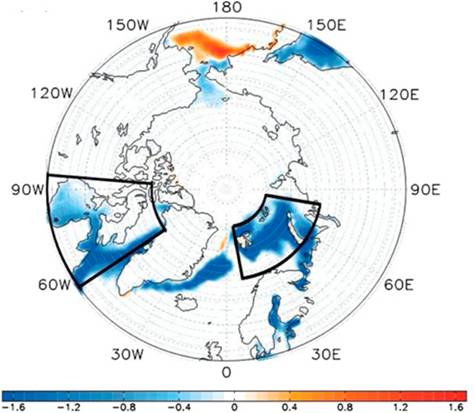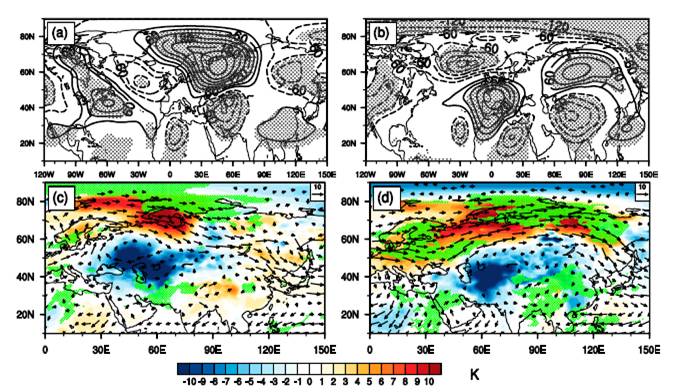Ural Blocking induces amplification of the Winter Warm Arctic–Cold Eurasian Anomalies
Date:2016-05-19
Atmospheric blocking is an important large-scale, low-frequency circulation in mid-high latitudes. The variability of blocking and its impact on extreme weathers and climates have attracted a great deal of interest.
Many studies have revealed that over the past decades, the arctic sea ice has undergone a rapid decline. The melting of sea ice has an important impact on Arctic weather and climate and even the middle latitude climate. Recently, Prof. LUO Dehai from the Institute of Atmospheric Physics (Chinese Academy of Sciences) and colleagues from USA, Australia and Germany investigated impact of Ural blocking on winter warm Arctic–cold Eurasian temperature anomalies (WACE) and obtained some interesting findings.
It is found that atmospheric pattern response to arctic sea ice loss resembles a negative Arctic oscillation (AO-) with a positive height anomaly over the subarctic region. The arctic sea ice reduction has two dominant subregions: the Barents and Kara Seas (BKS) and the North American high-latitude (NAH) region (Davis Strait, Baffin and Hudson Bay, and Labrador Sea) (Fig. 1). Regression analyses of the sea ice loss in two subregions further show that the BKS corresponds to the UB blocking together with a positive North Atlantic Oscillation (NAO+) and is followed by a WACE anomaly. The sea ice reduction in the NAH region corresponds to a NAO- pattern with a cold anomaly over northern Eurasia.

Figure.1 The area of the SIE linear trend (% yr-1). The two outlined areas represent the BKS and NAH.(Luo et al., 2016a)
Further analyses indicated that the UB blocking is more persistent during the period 2000–13 (P2) than 1979–99 (P1). This may due to the reduced middle-to-high-latitude mean westerly winds over Eurasia continent associated with the intense BKS warming. Because the long-lived UB often occurs with the NAO+, the BKS-warming-induced winter-mean anticyclonic anomaly is intensified and widened and then amplify the WACE pattern and lead to the southward displacement of its cold anomaly and the further loss of the BKS sea ice during P2. This suggested that the midlatitude Eurasian cold events will be more frequent as the sea ice loss continues over the BKS region.
By classifying the UB blocking events based on two cases studies of cold events that occurred over southern China in January 2008(Fig. 2). Study further examines how the UB variability affects quasi-biweekly WACE anomalies. Moreover, composite analysis during 1979–2013 shows that the QB-WACE anomalies associated with the UB that often occur with the NAO+ events are strong and can be controlled by the North Atlantic jet and zonal wind strengths over Eurasia continent.

Figure.2 Time-mean anomalies of (a),(b) 500-hPa geopotential height (gpm; contour interval = 30 gpm) and (c),(d) surface air temperature (colors) and areas with significant precipitation (green shading) for the two UB events averaged (left) from 30 December 2007 to 12 January 2008 (event 1) and (right) from17 to 30 January 2008 (event 2). In (a),(b), the gray stippling denotes the region above the 95% confidence level based on a two-sided Student’s t test and the red arrow denotes the anomaly vector of time-mean 850-hPa horizontal winds. In (c),(d), the dotted regions are above the 95% confidence level based on a two-sided Student’s t test and the dark arrows denote the time-mean 850-hPa total wind vector. Area with precipitation anomalies above the 95% confidence level are shaded in green. (Luo et al., 2016b)
Reference:
1) Luo, D., Y. Xiao, Y. Yao, A. Dai, I. Simmonds, and C. Franzke, 2016a: Impact of Ural Blocking on Winter Warm Arctic-Cold Eurasian Anomalies. Part I: Blocking induced amplification. J. Climate. 2016 29, 3925-3947.
2) Luo, D., Y. Xiao, Y. Diao, A. Dai, C. Franzke and I. Simmonds, 2016b: Impact of Ural Blocking on Winter Warm Arctic-Cold Eurasian Anomalies. Part II: The Link to the North Atlantic Oscillation. J. Climate. 2016 29, 3949–3971.
Contact:
Dr. YAO Yao, yaoyao@tea.ac.cn
